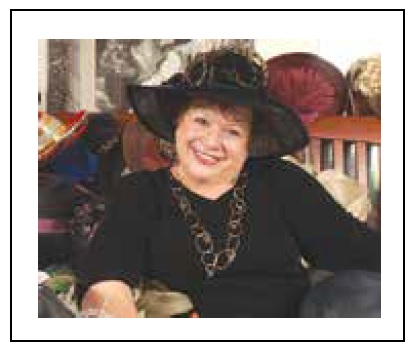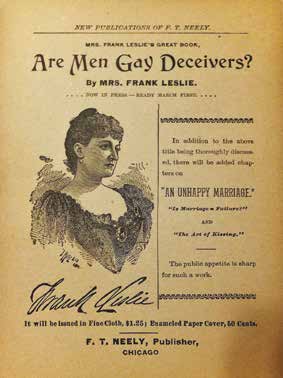
By Jan Wahl–
She’s how Oscar Wilde made his trip to America … and San Francisco! You might not know her name, but she ran one of the largest publishing empires in the U.S. during the Gilded Age (a period of rapid economic growth from roughly 1870–1900). She was scandalous, uber rich, and so fashionable it hurt. Her name was Miriam Leslie and there is finally a book about her, Diamonds and Deadlines: A Tale of Greed, Deceit, and a Female Tycoon in the Gilded Age by Betsy Prioleau. It tears the corset and bloomers off the often lurid and true tale of a rare businesswoman living a wild life during this glamorous time. OK … glamourous if you were rich. And she was—very!

Miriam’s carnival of excesses included poets, misfits, rip-off experts, and the wealthy Fifth Avenue folks whom she documented in her sensational magazines and newspapers. People think Hearst invented “yellow journalism,” but she was doing it before and selling millions from the exaggerated accounts of people, places, and things. Once you pick up this book you should get ready for travel into the Gilded Age with a strong, determined, and spirited woman. But she was also kind of nuts. I asked the author about this.
“Miriam began life as a prostitute,” Prioleau told me for the San Francisco Bay Times. “Then her sex life went off the charts, with a famed menage a trois, multiple marriages, and many affairs. Her second husband was a bisexual homoerotic writer who went off to South America as an anthropologist and brought home a ‘frolicking’ native young man to live with them.”

“Poet Joaquin Miller was a lover and very close friend who stood by her when others were shocked,” she continued. “In her monied set, she knew many ‘Boston marriages’: women who lived together openly and were accepted as being companions. Because of her background, she identified with outsiders. She supported Oscar Wilde through his controversial American tour. Later, she married Oscar’s drunken, lazy brother and became great friends with his Suffragist mother. Eventually, Miriam’s large fortune was left to the Suffragist movement. The weird part of that is that Miriam was all about fashion dos and don’ts that completely dictated what women and men should wear during this opulent time—more costumes than causes!”
There is one part of this woman that I could not figure out. She had ups and downs in her life that were amazing; hard times that would kill most of us. She made it through, and I asked Prioleau about Miriam’s ability to survive.
“Miriam had something rare: life-saving grandiosity,” she replied. “She had an ego the size of the Ritz. The historical drama The American Gilded Age really didn’t capture this. Miriam had ebullient charm and self-confidence. She firmly believed in her own power to fascinate.”
I’ll take that!
Here are a few other hot reads right now:
The Castle on Sunset: Life, Death, Love, Art, and Scandal at Hollywood’s Chateau Marmont by Shawn Levy
Sure, it was the place where John Belushi died, but before that it was a haven for lovers of all sorts, from Marilyn Monroe and Albert Einstein to Tab Hunter and Tony Perkins.
The Sewing Circle: Hollywood’s Greatest Secret: Female Stars Who Loved Other Women by Axel Madsen
Greta Garbo and Marlene Dietrich came to Hollywood with a new set of morals based in a bisexual European tradition. The first female director Dorothy Arzner and writers and stars followed closely, developing a secret society that influenced the strong women’s pictures of the 1930s and ’40s. I would so love it if our Rainbow Honor Walk would include Arzner.
Forbidden Hollywood: The Pre-Code Era 1930–1934 When Sin Ruled the Movies by Mark A. Vieira
Before the silly Motion Picture Production Code, sex on screen was steamy and visual. Vieira’s stunning prose and especially the remarkable photographs make us feel the heat between everyone from Clark Gable to Jean Harlow. When the Code brought in a sense of sexual fear, we all lost.
Behind the Scenes: How Gays and Lesbians Shaped Hollywood 1910–1969 by William J. Mann
I adore Mann’s books; he is a true student and teacher of Hollywood LBGTQ history. His biographies on Clara Bow and William Haines are fabulous, as is this one documenting the importance of the community in Hollywood. As Elizabeth Taylor put it: “Without gays and lesbians, there would be no Hollywood.” Right on. At least no Hollywood I’d ever love!
Jan Wahl is a Hollywood historian, film critic on various broadcast outlets, and has her own YouTube channel series, “Jan Wahl Showbiz.” She has two Emmys and many awards for her longtime work on behalf of film buffs and the LGBTQ community. Contact her at www.janwahl.com
Published on July 28, 2022
Recent Comments